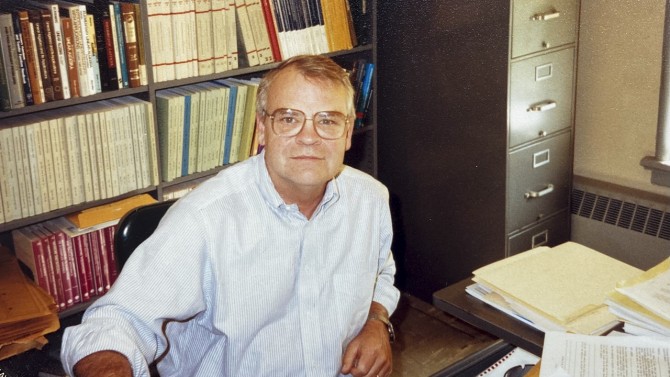Mathematician James H. Bramble dies at 90
By David Nutt
James H. Bramble, professor emeritus of mathematics in the College of Arts and Sciences, died July 20 at his home in Austin, Texas. He was 90.
In his 26 years at Cornell, Bramble helped move his department to the forefront of applied mathematics and became a leading figure in his field, bridging rigorous theory and practical numerical computation.
Bramble was born Dec. 1, 1930, in Annapolis, Maryland. He earned his bachelor’s degree from Brown University in 1953 and a Ph.D. from the University of Maryland in 1958. He then worked for General Electric, the Naval Ordnance Laboratory and the University of Maryland. In 1968, he was recruited to Cornell.
“Cornell hired Professor Bramble to help establish a world-class group in numerical analysis,” said Tara Holm, professor of mathematics and department chair. “That group began with his adviser, Larry Payne, and later included professors Lars Wahlbin and Al Schatz. Bramble was one of the top three in his field in the country and of worldwide renown. He put applied mathematics at Cornell on the world map, as it were. Bramble’s work remains central in applied mathematics and continues to be highly cited today.”
While Bramble’s five most highly cited works were written 25 to 35 years ago, they have all been continuously cited since then, each garnering five to 10 citations last year alone, Holm noted.
Bramble began his research career developing analytical methods for partial differential equations – that is, equations that relate functions and their derivatives. In the 1960s, he helped pioneer the mathematical analysis of finite difference methods for elliptical problems, and in the ensuing decades he focused on the numerical analysis of finite element methods.
A collaboration with one of his doctoral students, Stephen Hilbert, resulted in the Bramble-Hilbert Lemma, a theoretical tool for proving error estimates for the finite element method.
In 1970, he co-founded the Finite Element Circus, a conference devoted to the theory and applications of the method.
Bramble also made a significant impact with Cornell’s Center for Applied Mathematics. He served as its director from 1975-81, helping to secure university funding for graduate students. Bramble ultimately advised 22 doctoral students, who then went on to train 147 doctoral students, Holm said.
In addition, Bramble served as associate chair and director of undergraduate studies in the Department of Mathematics for three years, and as graduate faculty representative in mathematics for three years.
In 1994, he retired from Cornell as professor emeritus. He continued his career at Texas A&M University, where he retired as distinguished professor emeritus.
He was an editor at the journal Mathematics of Computation for 25 years, and chief editor from 1975-83. He received an honorary doctorate from Chalmers University of Technology in Sweden in 1985.
After retiring, Bramble and his wife, Peggy, remained in Austin, but returned to their lakeside cottage in Ithaca every summer.
Bramble was preceded in death by his wife Margaret (Peggy) Hays. His survivors include his four children, Margot Dermody, Tamara Lamenzo, Mitzi Bramble and James Bramble; his stepson, Alan Hays; eight grandchildren; and his first wife, Mary Eppie Boze.
Media Contact
Get Cornell news delivered right to your inbox.
Subscribe

